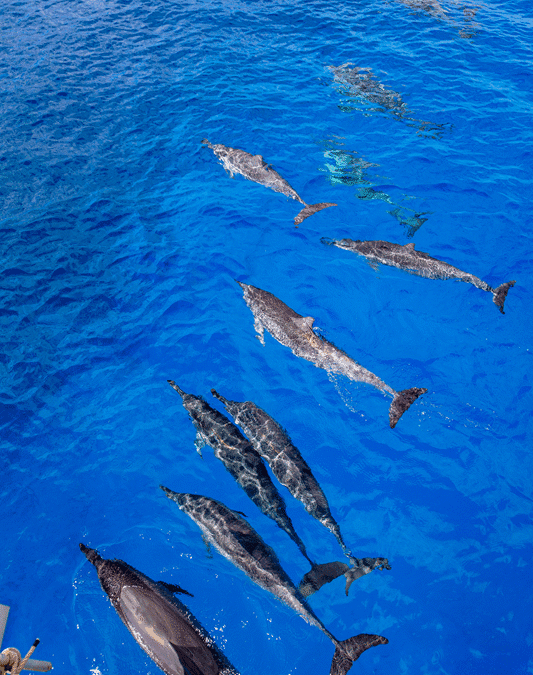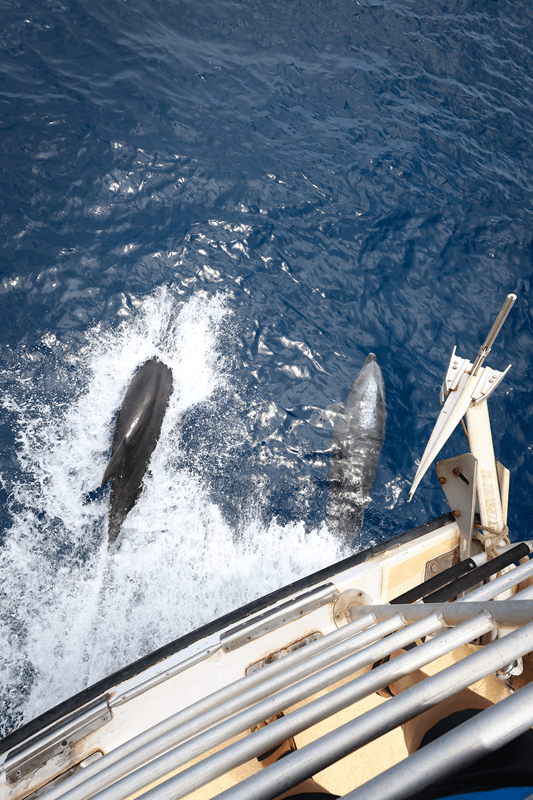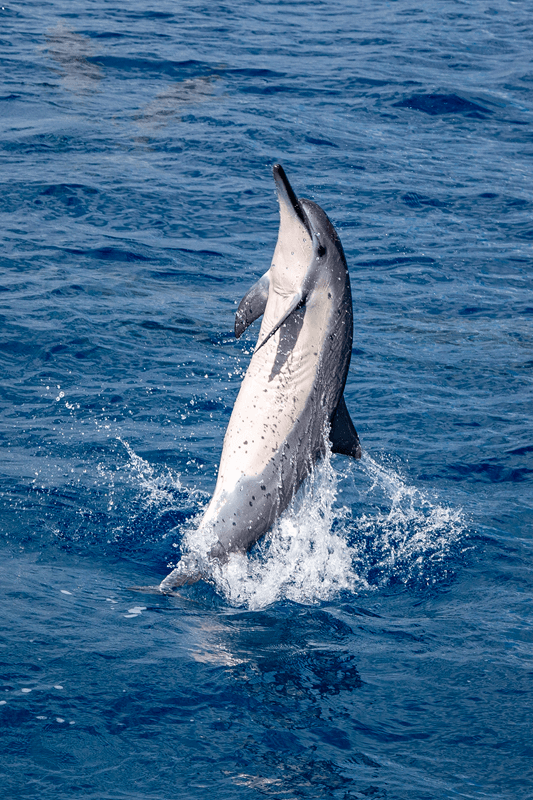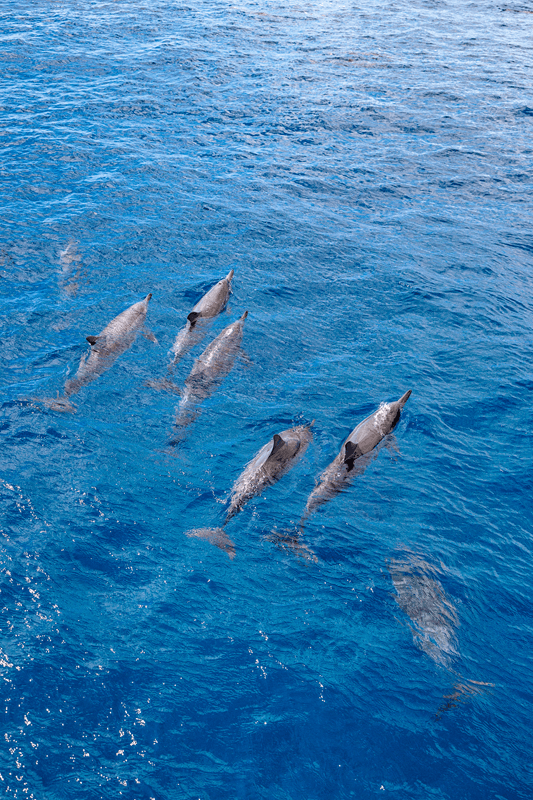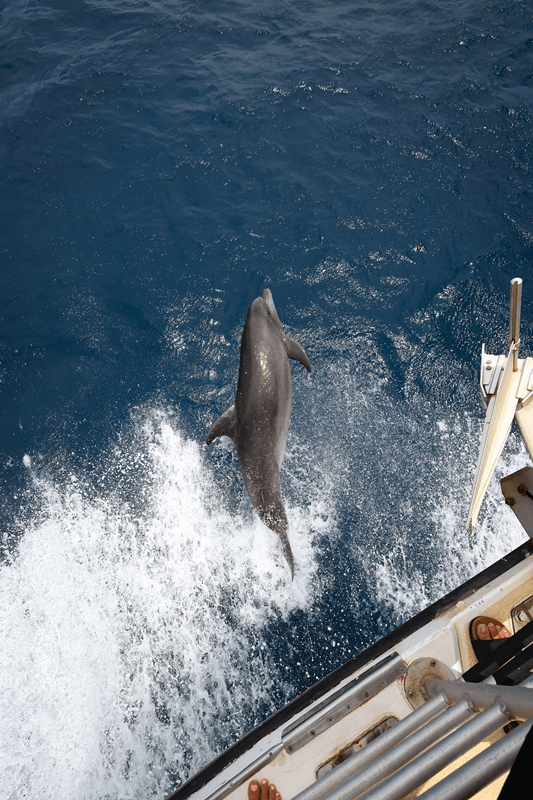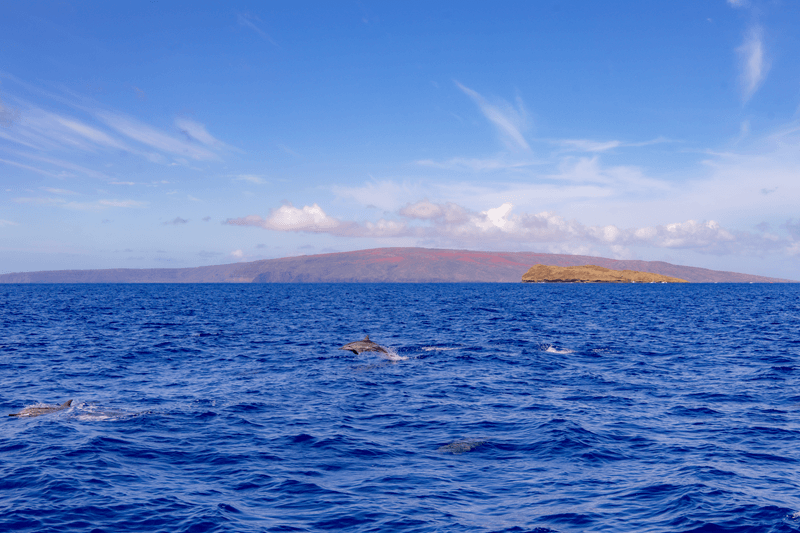Dolphins around Maui are curious, quick, and full of personality. While our crew never chases or crowds them (that’s not safe for anyone), seeing dolphins on the way to and from our snorkel sites is one of the island’s great “wow” moments.
Dolphins are only found in the wild around Maui if they choose to appear, which makes every sighting a special gift from nature. In this blog, you’ll learn what types of dolphin species you’re most likely to see, how to spot them, and the best, most respectful ways to watch.
Snorkel Maui
Bring your sense of wonder—and maybe your whole crew! Our snorkeling tours to Molokini Crater, Turtle Town, and Coral Gardens are the perfect mix of fun and discovery. Reserve your spot now and get ready for memories that will last a lifetime!
Meet Maui’s Dolphins
Several species of dolphins call the Hawaiian Islands home. Maui’s clear waters and healthy reef systems provide the perfect playground for them. On your snorkeling adventure, you might spot three main types: spinner dolphins, bottlenose dolphins, and spotted dolphins.
Spinner Dolphins
Hawaiian spinner dolphins are the most famous of all. These sleek, medium-sized dolphins get their name from their spectacular aerial shows. They leap out of the water and spin—sometimes five or six times before splashing back down!
Spinners are highly social, traveling in pods that can number from a few dozen to several hundred. Around Maui, they are often spotted along the south coast or near Molokini Crater. If you’re lucky, you might see them racing alongside our boat, leaping in unison, or simply gliding gracefully beneath the waves.
Bottlenose Dolphins
Larger and more robust than spinners, bottlenose dolphins are the ones most people picture when they think “dolphin.” Known for their intelligence and curiosity, they’re often seen swimming near boats, delighting guests with close-up appearances. Research shows coastal populations of bottlenose dolphins in Maui Nui often remain close to island shelves. This is why guests sometimes spot them during boat rides.
Bottlenose dolphins can be a surprise highlight of our snorkeling tour. Picture yourself standing at the rail, eyes on the horizon. Suddenly, a fin breaks the surface, and a dolphin leaps into the air. It’s a sight that makes your heart race.
Spotted Dolphins
Hawaiian waters are also home to spotted dolphins. Sleek and fast, they’re named for the patterns that develop on their bodies as they grow older. Though not as common around Maui as spinners or bottlenose dolphins, spotted dolphins are always a treat to see. They often travel in mixed groups, mingling with spinners and bottlenose, making for an unforgettable spectacle.
Quick Note: Don’t confuse Maui’s dolphins with the Māui dolphin of New Zealand—one of the smallest dolphins in the world. While they share a name, the Māui dolphin lives far from Hawaii.
Where Might You See Maui Dolphins?
Dolphins roam freely in Maui’s waters, so every encounter feels like a gift from nature. While there are no guarantees, there are a few places where sightings are more common.
On the way to Molokini Crater
Our boat travels through open channels where dolphins sometimes travel, feed, or transit. Mornings are great for smooth seas and long looks across the water. If you’re up for an early start, the Molokini Crater Snorkeling Tour runs 7:00 AM–12:00 PM. This tour includes gear and meals, and visits two sites (Molokini plus a second stop like Turtle Town, conditions allowing). It’s a relaxed, comfortable way to keep watch for wildlife from a stable deck. (As always, wildlife sightings aren’t guaranteed.)
In the Afternoon Sunshine
Prefer to sleep in? The Afternoon Snorkeling Tour runs 1:00 PM–4:00 PM and is a mellow, family‑friendly option. Light lunch, reef‑safe sunscreen, and snorkel gear are on us; you bring your sense of adventure. Keep scanning for dorsal fins as we cruise—sometimes dolphins pop up when you least expect them!
Along Maui’s Coastline
South Maui and the Lahaina Pali coastline are both areas where dolphins may appear. Whether you’re hiking above the ocean or cruising by boat, keep your eyes peeled—you never know when a pod will surface.
Snorkeling With Respect
Dolphins are incredible to watch, but they are also protected animals in Hawaii. It’s important to respect them and follow local guidelines.
- Never chase or approach dolphins. Interactions should always be on their terms.
- Do not feed them. Dolphins are skilled hunters and rely on natural food sources.
- Stay calm and quiet. Splashing or shouting can scare them away.
Dolphins face threats far beyond Hawaii. In the United States, especially along the West Coast and the eastern tropical Pacific, some populations have struggled with entanglement in fishing gear. By choosing responsible tours in Maui, guests help support dolphin conservation and enjoy encounters that are safe for both people and wildlife.
Different dolphin species thrive in very different habitats. Some live in colder, enclosed waters like the Black Sea, while Maui’s dolphins prefer warm, coastal environments. No matter where they live, they face similar threats from human activity, which is why respecting them in the wild is so important.
At Maui Snorkeling, we believe the best encounters are the natural ones. That’s why our tours never chase or disturb dolphins. If they choose to swim alongside our boat, it’s a gift—and one that always leaves guests in awe!
Spinner Dolphins 101
Let’s dive a little deeper into the Maui spinner dolphins.
Their Daily Rhythm
Hawaiian spinner dolphins hunt small fish and squid far offshore at night. After that long commute, they return to the island’s calm, clear bays to rest during the day. They often stay in tight groups over sandy bottoms where they can keep an eye out for predators.
If their rest is disturbed, spinners lose the energy they need for night feeding. That’s why we never enter resting bays or crowd them in the water.
Respecting Resting Bays
NOAA has proposed time‑area closures at several key resting bays in Hawaiʻi (including La Perouse Bay on Maui) during core day‑rest hours. The goal is to give dolphins quiet space while allowing people to enjoy the coast responsibly. Always check the latest rules before you go.
The Golden Rule: Give Dolphins Space (It’s the Law for Spinners)
The 50‑Yard Rule (Spinner Dolphins)
In Hawaiʻi, it’s illegal to swim with, approach, or remain within 50 yards of a spinner dolphin—for people, boats, drones, kayaks, everyone—within 2 nautical miles of shore and in the designated waters between Maui, Lānaʻi, and Kahoʻolawe. The law also bans “leapfrogging,” or positioning a vessel in a dolphin’s path so they end up within 50 yards of you.
Recommended Distances For All Dolphins
NOAA’s viewing guidelines for Hawaiʻi recommend staying at least 50 yards from all dolphins and small whales, and 100 yards from humpback whales. These distances keep animals safe and help you avoid unintentional harassment under the Marine Mammal Protection Act.
Bottlenose Dolphins 101
Bottlenose Dolphins are the dolphins most people picture—robust body, curved dorsal fin, and friendly grin. Bottlenose dolphins living in Hawaiian waters have adapted to both shallow bays and deeper offshore areas. This gives snorkelers a chance to see them in different habitats.
In Maui Nui (Maui, Lānaʻi, Molokaʻi, and Kahoʻolawe), research teams have documented resident, island‑associated groups that spend a lot of time in waters less than 500 meters deep. That’s one reason guests sometimes see them during the boat ride to and from snorkel sites.
Their curious nature makes common bottlenose dolphins a favorite among snorkelers and boaters. These dolphins are known to ride the bow waves of boats, leaping gracefully alongside as if they’re showing off for their human audience.
While sightings are never guaranteed, catching a glimpse of them on your way to Molokini Crater or Turtle Town is always a thrill. It’s those spontaneous moments—when a dolphin surfaces just a few feet away—that turn an ordinary snorkeling trip into a story you’ll tell for years.
Spotted Dolphin 101
If you love Maui Dolphins, the spotted dolphin will steal your heart. They’re quick, social, and—yes—spotted. But here’s the twist: those famous spots show up with age. Calves start out plain gray and gain speckles as they grow, often with a dark “cape” on the back and a slim, white‑tipped beak.
Where (and When) You Might See Them Around Maui
Spotted Dolphins live in both shallow and deep waters, but they are often seen in the open ocean. Around Maui, surveys show they appear more in deep channels than close to shore. That’s why boat travel time—like your cruise to Molokini or your return from the reef—is prime scanning time.
They’re also commonly sighted in the Maui Nui region, right alongside Spinner and Bottlenose Dolphin groups. Scientists recognize island‑associated stocks here (including a “4‑Islands” stock for Maui, Lānaʻi, Molokaʻi, and Kahoʻolawe), which helps explain why you’ll meet them in these waters.
When Spotted Dolphins travel, they may move in pods of dozens to hundreds, sometimes mixing with other dolphin species. Keep an eye on bird activity and smooth, traveling fin lines—those are your clues.
Quick ID: Spinner vs. Bottlenose vs Spotted
Spinner Dolphin—What to notice
- Build: slender and small compared to bottlenose
- Beak: long and thin
- Color: dark gray back, paler sides, light belly (three‑tone look)
- Behavior: aerial spins, high‑energy socializing when not resting
- Where/When: nearshore days (rest), offshore nights (feeding)
Bottlenose Dolphin—What to notice
- Build: robust torso, thicker head
- Beak: short “bottle‑like” snout
- Color: gray on top, lighter underside
- Behavior: steady travel lines; may forage cooperatively
- Where/When: flexible—bays, coastlines, shelf waters, and beyond
Spotted Dolphin—What to notice
- Build: slender body, curved dorsal fin. Babies = no spots; teens = freckles; adults = lots of spots.
- Beak: long
- Color: darker back (“cape”), lighter sides, pale belly
- Behavior: often lively; they can be chatty and playful at the surface
- Where/When: nearshore and offshore, Maui Nui region
Keep the Learning Going: More Marine Life Reads
If you love Maui Dolphins, you’ll love the rest of Maui’s reef cast. Explore a few more of our blogs:
- Ornate Butterflyfish: runway‑ready stripes and reef glam.
Meet the Ornate Butterflyfish - Yellow Tang: the island’s bright burst of sunshine.
Sunshine of the Reef: The Yellow Tang - Spotted Eagle Rays: graceful “underwater birds.”
A Glimpse into the World of Spotted Eagle Rays - Eels: shy neighbors with big personalities.
Get to Know Maui’s Moray Eels, Snake Eels, & More
- Ornate Butterflyfish: runway‑ready stripes and reef glam.
Or browse our full Marine Life category for more.
Maui Snorkeling Tours
Ready to meet Maui’s dolphins and explore the island’s best reefs? Join us on a Maui Snorkeling tour and let the ocean surprise you with its magic. Book today and make your Maui adventure unforgettable!
Final Splash
Seeing dolphins in the wild is an unforgettable part of any Maui vacation. While they’re never guaranteed, the chance to watch them leap, spin, or glide past our boat adds an extra layer of magic to an already amazing snorkeling adventure.
Even if dolphins don’t appear, you’ll still snorkel vibrant reefs, swim with turtles, and see bright tropical fish. Add in the comfort of our all-inclusive tours, and you’ve got the perfect Maui day.
So why wait? Book your snorkeling adventure with Maui Snorkeling today, and let the dolphins of Maui surprise you with their playful spirit. Whether you see them leaping beside the boat or hear the delighted laughter of fellow guests, you’ll carry the joy of Maui’s waters long after you leave the island! 🐬

